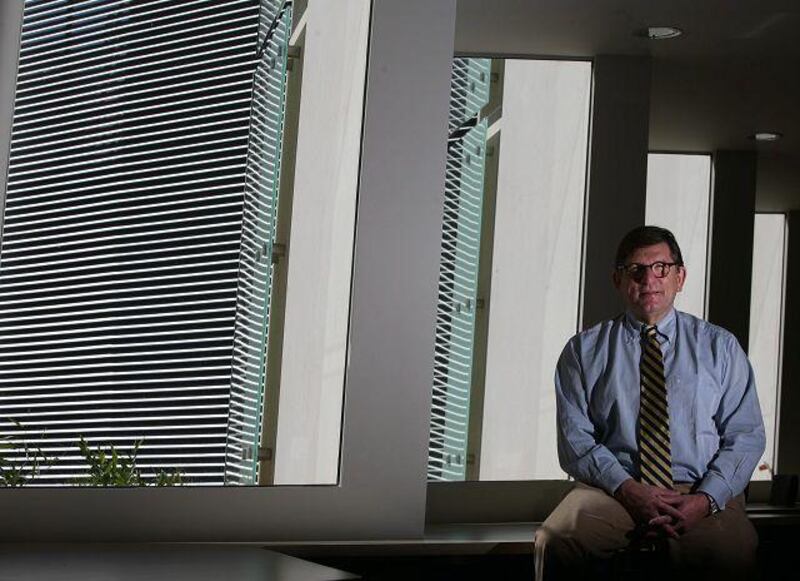SYDNEY // The painstaking hunt for a cure for cancers caused by asbestos fibres has received a much-needed boost with the opening of an international research project in the Australian city of Sydney. The Bernie Banton Centre, named after an Australian social justice campaigner who died from asbestos-related illnesses in Nov 2007, is the world's largest facility dedicated to providing early diagnosis and treatment for victims. Asbestos is the commercial name given to a silicate mineral used commonly in such building products as insulation and roofing for its durability and resistance to fire. Banned in many developed countries, the incombustible material is mined extensively in Canada and exported to India and Russia, but Australia is one of the world's most contaminated areas, where tens of thousands of homes remain riddled with asbestos. It is a lethal carcinogen and can cause inflammatory diseases of the lungs, including asbestosis which over time erodes the organ's ability to function, inflicting great pain and breathlessness. There are also malignant cancers that are associated with asbestos. Mesothelioma taints the tissue that covers the inner surfaces of the lung and abdomen, which is difficult to treat and where the prognosis for sufferers is often dismal. Lung cancer too has been linked to asbestos, which has a grievous ability to inflict anguish and death on those who have ingested its microscopic filaments. "Near the end, the pain becomes unbearable for sufferers of mesothelioma and lung cancer," said Barry Robson, president of the Asbestos Diseases Foundation of Australia. "People with asbestosis are constantly fighting for breath and it's like they're drowning within themselves, and to see people dying this way is terrible. For the asbestosis people it is such a long-term disease it can go on for years and years. "On the other hand, we have mesothelioma victims who for the majority it is only a short time. On average they have 155 days from diagnosis to death. It is a very, very aggressive cancer." Mr Robson said the Bernie Banton Centre would be of great importance to sufferers both in Australia and abroad. "The idea is to pull all the research together from all over the world and have it all in the one place," he said. Chemotherapy has been used successfully in some cases, especially when combined with surgery and radiation therapy, while researchers in Sydney are concentrating on identifying the paths the diseases take through the body and genetic triggers. Professor Nico van Zandwijk, the inaugural director of the Bernie Banton Centre, said unlocking the secrets of asbestos-related ailments such as mesothelioma remains a huge challenge. "The latency period from first exposure to the disease is alarming, sometimes 30 to 40 years," Prof van Zandwijk said. "Why that is so long is because we think it is a chronic inflammation process which causes DNA damage and eventually after years of inflammation you develop one of those cancers. "I think that is indeed frightening, especially if you reckon that you have been exposed to asbestos. That knowledge may hang as a dark cloud above you." Prof van Zandwijk said people had different levels of sensitivity to asbestos, which was probabaly a result of genetic differences of the immune system. He added that the material posed the greatest danger when properties containing it were being demolished, releasing fibres into the air and thus presenting the risk of inhalation. Most victims are unwittingly exposed to asbestos when refurbishing houses or knocking down old sheds or toilets. Up to 700 people a year are diagnosed with mesothelioma in Australia. By 2020, it is estimated that 40,000 Australians will have asbestos-related cancers. "When the doctor told me I had mesothelioma, I had to have it explained to me. I didn't know what it was. My life just crumbled," said Carol Klintfalt, a 59-year-old grandmother from Sydney, who is in constant pain. "When I was in my early twenties I worked for an architect in Sydney and he was renovating old hotels and nightclubs and there was so much asbestos around then. I remember dust in the air." "I can't go on with my life thinking 'Why me'? I've gone through so many emotions; anger and fear and now I'm living not to fight cancer but to enjoy my family. I've no idea what tomorrow holds." For thousands of people struck down by tiny asbestos fibres, the new research centre in Australia is providing a glimmer of hope. "It is for people like me," Mrs Klintfalt said. "The longer I can live the more chance we feel that there could be a breakthrough. "If you are stripped of hope you roll over and give up, so I forever live in hope that something will be found. It is a man-made cancer, now man's got to find the cure." pmercer@thenational.ae
New lifeline for asbestosis sufferers
The painstaking hunt for a cure for cancers caused by asbestos fibres has received a much-needed boost.

More from the national




